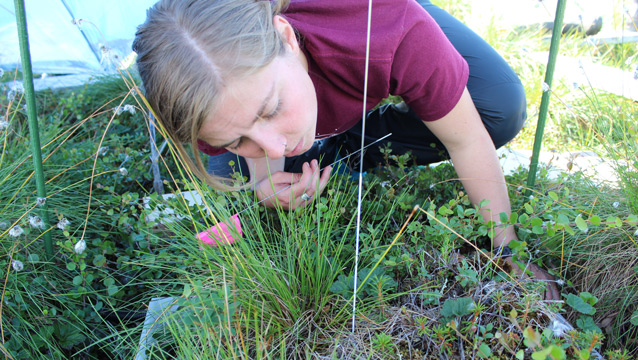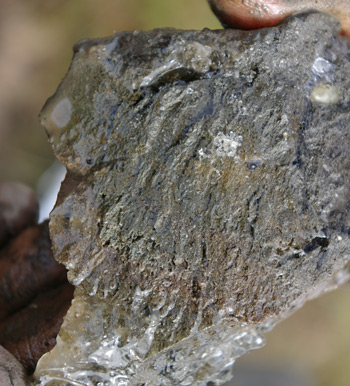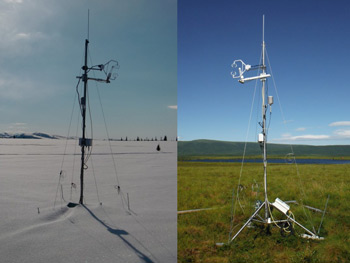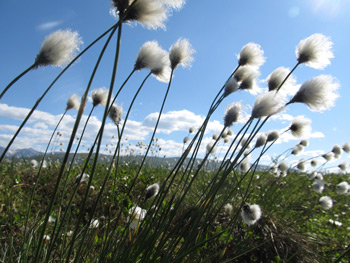How Do Animals Return Carbon Directly Into The Atmosphere?

Subarctic environments such as Denali National Park and Preserve's tundra and boreal forest, have undergone drastic changes over the past few decades, likely as a result of a changing climate–increasing temperatures. Because Denali lays at the southern limits of permafrost, the boilerplate temperature of the park's permafrost hovers just below freezing, making it especially sensitive to thawing with just a modest increase in mean annual temperature. Warmer temperatures are expected to thaw permafrost, which will greatly bear upon ecosystems locally. Simply one of the farthest–reaching consequences of climate change in northern ecosystems may exist the consequence of thawing permafrost on the global carbon cycle.
Net Balance of C
More than 50% of global terrestrial carbon (C) is stored in permafrost regions equally soil organic matter. Carbon naturally enters any terrestrial ecosystem by photosynthesis, since plants accept in carbon dioxide (CO2) from the atmosphere every bit they grow. Carbon returns to the atmosphere CO2 from the metabolic respiration of plants, animals, and microbes (bacteria). In h2o logged areas carbon tin can also be released in the class of methane (CH4). The ecosystem carbon balance is the divergence betwixt carbon uptake and emissions.
When carbon uptake by plant growth is greater than carbon emissions by metabolic respiration, the ecosystem is a carbon sink, meaning that atmospheric C is stored in biota and soils. When carbon emissions are greater than carbon uptake, the ecosystem is a carbon source, meaning that carbon from the ecosystem is released (from biota and soils) to the atmosphere.

Potential Furnishings of Thawing Permafrost
Permafrost thaw associated with climate warming tin can lead to 2 different impacts that change ecosystem carbon balance to a sink or a source. Warming increases plant growth and it promotes the invasion of shrubs and trees into tundra landscapes. These processes can increase the amount of C stored in institute biomass thus reducing the amount of C in the temper.
At the same time, permafrost thaw and the associated environmental changes (east.g., footing surface collapse or subsidence) stimulate the microbial decomposition of soil organic matter. This decomposition tin decrease the corporeality of stored C by releasing more than CO2 into the atmosphere.
These metabolic by-products (CO2 and CH4) are the aforementioned "greenhouse gases" involved in climate change. Thus, when permafrost thaws it may affect the cycling of C to or from the atmosphere which tin can create boosted global-calibration impacts.

Studying the Effects of Permafrost Thaw on C
To larn more than about how permafrost thaw impacts the ecosystem carbon balance, Dr. Ted Schuur of Northern Arizona Academy, conducts research at a site only exterior the northeastern boundary of the park. This tundra site near Viii Mile Lake is underlain by permafrost that researchers first noticed was thawing in the 1980'southward.
Schuur and his research grouping continuously mensurate soil temperature and moisture using sensors continued to a data-logger to track physical changes in the environment equally the permafrost thaws. The site'due south carbon balance is monitored using an boil covariance tower that measures the current of air speed and management as well as the CO2 concentration of the temper. The site is a well-tuckered wetland so the contribution of CH4 to the landscape carbon balance is minimal. Data from the tower sensors are then analyzed to determine the Net Ecosystem Exchange (NEE) of CO2 between the tundra and the atmosphere.

Every twelvemonth, the NEE of the tundra mural oscillates between beingness a carbon source in the winter and a carbon sink during the growing flavor (May to September). During the growing season, NEE is negative and indicates that the mural is interim as a carbon sink of atmospheric CO2. This is because growing tundra plants incorporate carbon into new leaves, roots and stems through the procedure of photosynthesis, outweighing CO2 losses from metabolic processes. During the winter, nonetheless, it is too cold and dark for plants to photosynthesize then the tundra landscape has a positive NEE. A positive NEE rate shows that landscape is interim as a carbon source: it is releasing CO2 from plants and soils to the atmosphere. This CO2 is released as tundra plants and soil microbes break down carbon compounds and employ the energy stored in those carbon compounds to fuel their metabolism. Metabolic respiration of CO2 by plants and microbes takes identify twelvemonth round just during the growing season this release of CO2 is overshadowed past the photosynthetic uptake of CO2 of the found community.
Dr. Schuur and his squad monitor NEE year circular so that they can capture daily and seasonal changes in the mural carbon balance as permafrost thaws. Twelvemonth round measurements of NEE are also used to determine whether the force of the growing flavor carbon sink is equal to the forcefulness of the winter carbon source. When this is true, the ecosystem carbon balance is stable and the carbon storing capacity of the landscape does not change. The long–term carbon balance of a permafrost landscape is important because it allows scientists to understand how this ecosystem is responding to climate alter.
Findings: 6 years of carbon balance monitoring
Monitoring the ecosystem C balance of the tundra about Viii Mile Lake has revealed that that this landscape acted as a net carbon source from 2008–2013. Photosynthesis by plants in the growing flavor did non start the year circular metabolic respiration by plants and soils in five of the six years studied. As a result, the carbon storing capacity of this landscape was reduced from 2008 to 2013: 276.25 k of C was lost from each m2 of tundra. This C was previously stored in tundra plants and soils was released to the atmosphere in the form of CO2.
Carbon dioxide is a greenhouse gas that is expected to further accelerate global warming and could crusade further thaw of permafrost in the future so it is critical that the scientific community understands whether the carbon balance at this site is typical of warming tundra landscapes. Dr. Schuur and his enquiry team interact with permafrost researchers from around the world to compare results from sites and determine the affect permafrost thaw will have on our hereafter climate.
Source: https://www.nps.gov/articles/denali-permafrost-carbon.htm
Posted by: harvardwithereas1986.blogspot.com

0 Response to "How Do Animals Return Carbon Directly Into The Atmosphere?"
Post a Comment